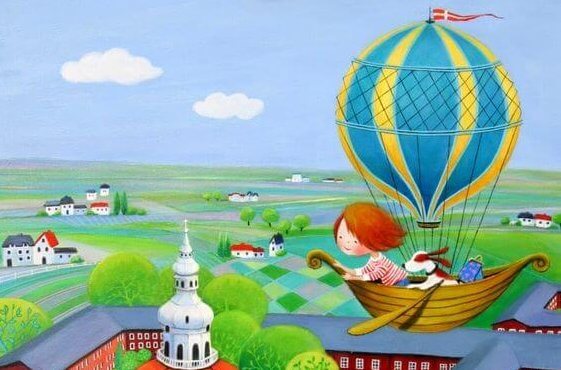Your Home Is Your Child's First Place of Education


Written and verified by the psychologist Valeria Sabater
Your house, your home, is the first social environment that your child will encounter. It is the place where your little one will receive the emotional and educational teachings that will guarantee his psychological well-being.
Your home is the place where he will be hugged and kissed. It’s where he’ll learn to say thank you.
What your child learns in your home will help him grow up to be a happy, respectful and upstanding person.
Sociologists and psychologists know very well that the dynamics that occur behind the closed doors of the home affect people in a direct way.
What happens inside those walls is sometimes a mini version of society itself. A home can be a place ruled by educational democracy, or it can be a dictatorship.
At the same time, we need to understand clearly from the start as mothers and fathers what type of upbringing we want for our kids.
Each word, action and gesture will not just leave its mark on your child’s brain; it will leave a mark on the subtle and invisible fabric that makes up your home.
Experts in psychological climate can make observations based on interactions that take place between members of a social group. By analyzing the way family members interact, they can make an easy emotional read of the home environment.
Sometimes, just by looking at a face or hearing the tone in someone’s voice is all they need. This information can reveal if the home is a place where happiness reigns or where unhappiness floods the floors and walls.
We should be conscious of this fact: A home is a refuge and a psychological and emotional point of reference for every child. So let’s build the most beautiful, inviting, happy and meaningful home we can for this new life.

My house may be small, but it is full of big hearts
Some homes are bigger on the inside than they are on the outside. Sometimes all you need to do is step over the threshold to breathe in the balance.
You can see the affection written on the faces of those who live there. Respect floats in the air. You can feel the joy of a child that grows up thinking he lives in a castle.
Without a doubt, these are the happiest homes. In these families, we see some characteristics that are worth taking some time to reflect upon.
A home where positive emotions dominate
Homes where positive emotions dominate are homes in which the inhabitants are people with Emotional Intelligence.
- In order for positive emotions to be present, we need to learn to deal with the negative emotions. When there is anger, for example, no one hides it or fakes it, but rather talks it out with respect and assertiveness in order to come to an agreement.
- At the same time, in the type of home where happiness and harmony live, there also live people who understand with empathy. They are capable of putting themselves in one another’s shoes in order to understand their point of view. They know how to provide solutions.
- A happy home is also a home where education includes positive emotional caresses. These include hugs, closeness, kisses, and a loving fabric where every child feels valued and protected.

A home that educates with values
Educating with noble values is a tool that allows you to raise more civil children for the world. It’s a way to raise children who are concerned for others, for nature, and for building a more harmonious world.
- Given that parents are a child’s first role models in this social fabric, early education in the home is key. From a very young age, children need to learn simple things like saying thank you, sorry, and good morning. Learning to use these simple phrases will teach your child much more than just common courtesy.
- We can’t forget that behind these social demonstrations of respect, children learn the effect they have on their surroundings. When they say thank you or sorry, they perceive almost instantly that these words have power. They are words that bring people together and earn respect, friendship, and recognition.
Values are social constructions that integrate a noble way of understanding life and the world. They include things like loving nature and animals, valuing equality and justice, protecting the weak, helping others, reading, knowledge, freedom, etc.
Therefore, if we educate our children with good values, we will be giving the world truly special people.

In conclusion, never forget that a house is much more than walls with windows where we can live and find shelter. A house is a place where we live together. It is like a second uterus where a child learns the most important lessons.
Images courtesy of IWONA LIFSCHES
Your house, your home, is the first social environment that your child will encounter. It is the place where your little one will receive the emotional and educational teachings that will guarantee his psychological well-being.
Your home is the place where he will be hugged and kissed. It’s where he’ll learn to say thank you.
What your child learns in your home will help him grow up to be a happy, respectful and upstanding person.
Sociologists and psychologists know very well that the dynamics that occur behind the closed doors of the home affect people in a direct way.
What happens inside those walls is sometimes a mini version of society itself. A home can be a place ruled by educational democracy, or it can be a dictatorship.
At the same time, we need to understand clearly from the start as mothers and fathers what type of upbringing we want for our kids.
Each word, action and gesture will not just leave its mark on your child’s brain; it will leave a mark on the subtle and invisible fabric that makes up your home.
Experts in psychological climate can make observations based on interactions that take place between members of a social group. By analyzing the way family members interact, they can make an easy emotional read of the home environment.
Sometimes, just by looking at a face or hearing the tone in someone’s voice is all they need. This information can reveal if the home is a place where happiness reigns or where unhappiness floods the floors and walls.
We should be conscious of this fact: A home is a refuge and a psychological and emotional point of reference for every child. So let’s build the most beautiful, inviting, happy and meaningful home we can for this new life.

My house may be small, but it is full of big hearts
Some homes are bigger on the inside than they are on the outside. Sometimes all you need to do is step over the threshold to breathe in the balance.
You can see the affection written on the faces of those who live there. Respect floats in the air. You can feel the joy of a child that grows up thinking he lives in a castle.
Without a doubt, these are the happiest homes. In these families, we see some characteristics that are worth taking some time to reflect upon.
A home where positive emotions dominate
Homes where positive emotions dominate are homes in which the inhabitants are people with Emotional Intelligence.
- In order for positive emotions to be present, we need to learn to deal with the negative emotions. When there is anger, for example, no one hides it or fakes it, but rather talks it out with respect and assertiveness in order to come to an agreement.
- At the same time, in the type of home where happiness and harmony live, there also live people who understand with empathy. They are capable of putting themselves in one another’s shoes in order to understand their point of view. They know how to provide solutions.
- A happy home is also a home where education includes positive emotional caresses. These include hugs, closeness, kisses, and a loving fabric where every child feels valued and protected.

A home that educates with values
Educating with noble values is a tool that allows you to raise more civil children for the world. It’s a way to raise children who are concerned for others, for nature, and for building a more harmonious world.
- Given that parents are a child’s first role models in this social fabric, early education in the home is key. From a very young age, children need to learn simple things like saying thank you, sorry, and good morning. Learning to use these simple phrases will teach your child much more than just common courtesy.
- We can’t forget that behind these social demonstrations of respect, children learn the effect they have on their surroundings. When they say thank you or sorry, they perceive almost instantly that these words have power. They are words that bring people together and earn respect, friendship, and recognition.
Values are social constructions that integrate a noble way of understanding life and the world. They include things like loving nature and animals, valuing equality and justice, protecting the weak, helping others, reading, knowledge, freedom, etc.
Therefore, if we educate our children with good values, we will be giving the world truly special people.

In conclusion, never forget that a house is much more than walls with windows where we can live and find shelter. A house is a place where we live together. It is like a second uterus where a child learns the most important lessons.
Images courtesy of IWONA LIFSCHES
All cited sources were thoroughly reviewed by our team to ensure their quality, reliability, currency, and validity. The bibliography of this article was considered reliable and of academic or scientific accuracy.
- Bowlby, J. (1986). Vínculos afectivos: formación, desarrollo y pérdida. Madrid: Morata.
- Bowlby, J. (1995). Teoría del apego. Lebovici, Weil-HalpernF.
- Garrido-Rojas, L. (2006). Apego, emoción y regulación emocional. Implicaciones para la salud. Revista latinoamericana de psicología, 38(3), 493-507. https://www.redalyc.org/pdf/805/80538304.pdf
- Marrone, M., Diamond, N., Juri, L., & Bleichmar, H. (2001). La teoría del apego: un enfoque actual. Madrid: Psimática.
- Moneta, M. (2003). El Apego. Aspectos clínicos y psicobiológicos de la díada madre-hijo. Santiago: Cuatro Vientos.
This text is provided for informational purposes only and does not replace consultation with a professional. If in doubt, consult your specialist.








